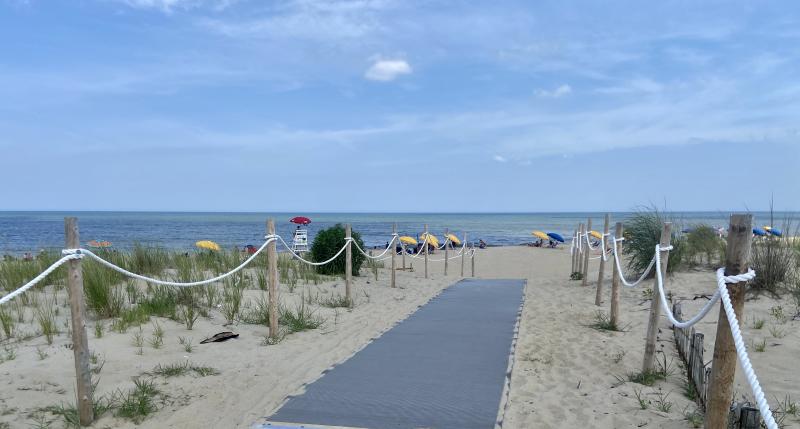State outlines dune fencing strategy in Dewey
While many people are accustomed to wire-and-slat fencing on the beach, a state official said a post-and-rope fence system recently installed in Dewey Beach offers more advantages.
Delaware Department of Natural Resources and Environmental Control representative Jesse Hayden outlined the post-and-rope dune fencing strategy at the Dewey Beach commissioners meeting July 15.
DNREC is transitioning to post-and-rope fencing in some places, Hayden said. In Dewey, installation of the post-and-rope fencing began in late fall and was completed around the Mother’s Day nor’easter, and beachgoers questioned the efficacy of the new fence system.
Snow fences are great at keeping people out of the dunes, which is the primary goal of the fencing, Hayden said, because they create a solid barrier and also accumulate sand that blows in the wind.
“In the ’80s and ’90s when water was impacting structures, we wanted to capture as much sand as possible on the beach, so using that snow fence was critical to growing the dune and growing the beach,” Hayden said.
DNREC started testing a post-and-rope system in Fenwick Island because it has an enormous dune and is not subject to as much erosion, Hayden said. A post-and-rope fence allows windblown sand to blow past the fence line and get trapped by vegetation, he said.
Continuing to grow the dune wider is not feasible because the dune can only grow to a certain size, Hayden said. Every time it grows a foot vertically it grows at least another 4 feet horizontally, Hayden said, and eventually there will be no beach.
“We saw that happen in Lewes a couple years ago,” Hayden said. “Their dune was growing so rapidly that grass was growing out onto the berm, the flat part people like to sit on, that we were getting complaints the beach was too narrow.”
DNREC received similar criticism after post-and-rope fencing was installed in Lewes until it was apparent it was working, Hayden said. Post-and-rope fencing also significantly reduces daily crossover maintenance as well, he said.
Hayden acknowledged that post-and-rope fencing is more of a symbolic fence that people and dogs can go under or over, but DNREC has not yet seen widespread damage due to trespassing on the dunes. Right now, he said, the post-and-rope fence allows for a more natural flow of sand across the dunes, and its advantages outweigh the disadvantages.
The dunes in Dewey Beach are at the same stage as in Fenwick, he said, and don’t need to grow any wider and take up more berm.
After the meeting, Town Manager Bill Zolper said the town is working with DNREC to ensure the post-and-rope fences are maintained in working order.
“DNREC has told the town to bring any issues with the posts and ropes to their attention and they will fix the issue in a timely fashion,” Zolper said. “Our maintenance team, along with the lifeguards, monitor the condition of the posts and ropes and report issues to DNREC.”
Regarding the beach nourishment project that is done every three years, Hayden said he expects the project to begin in fall 2022 and be completed before Memorial Day 2023.
Dewey is set to get berm nourishment only because the dune is big enough, Hayden said. The U.S. Army Corps of Engineers project includes Rehoboth, Dewey, Fenwick, Bethany and South Bethany, and will go out to bid next month, he said.























































